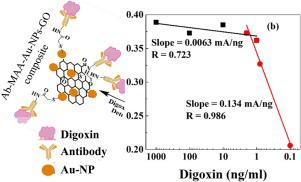地高辛是强心苷,被广泛用作治疗充血性心力衰竭和心律不齐的药物。不幸的是,地高辛的治疗范围很小(2 ng / mL),血浆中过量的地高辛浓度会引起中毒。因此,需要简单而灵敏的程序来严格监测血液中的地高辛,以最大程度地降低毒性风险。在本文中,我们报告了使用湿化学合成的Au-NP和GO复合材料检测地高辛的方法。X射线衍射(XRD),扫描电子显微镜(SEM)和拉曼光谱用于确定金纳米颗粒在GO表面的附着。将合成的Au-NPs-GO复合材料沉积在玻璃碳电极(GCE)的表面上进行电化学表征。将电极与巯基乙酸(MAA)和地高辛抗体(Ab)进一步温育,以形成Ab-MAA-Au-NPs-GO修饰电极。MAA共轭导致Ipc增加35%,电荷转移电阻降低63%(Rct)。抗体固定在MAA修饰电极上导致两个阴极峰(阳极峰)电流Ipc(Ipa)突然下降。R ct增加Ab功能化后(940Ω)是由于其蛋白质性质,这证实了Ab-MAA-Au-NPs-GO修饰的GCE传感器的形成。进一步扩展了工作以探索地高辛不同稀释度下的电荷转移特性。随着地高辛药物从0.1 ng / mL增加到1000 ng / mL,Ipc(Ipa)降低17%(10%)。最后还进行了线性扫描伏安法(LSV),以分析Ab修饰的传感器对各种地高辛药物稀释液的分析性能。记录了针对地高辛药物稀释的电流响应的两个线性回归,这证实了传感器的灵敏度由抗体和地高辛药物之间的相互作用(由电活性位点处的钾离子协调)控制。灵敏度为154.81μAcm- 2 ng -1对于2-0.1 ng范围和10.71μAcm -2 ng -1在1000-2 ng范围内。检出限(LoD)为0.19 ng / mL,表明所提出的Ab-MAA-Au-NPs-GO修饰GCE电化学传感器可成功用于将来的地高辛药物检测应用。
 "点击查看英文标题和摘要"
"点击查看英文标题和摘要"
Ultrasensitive electrochemical detection of digoxin using graphite oxide and Au-NPs composites
Digoxin is a cardiac glycoside which is widely used as medication in treatment of congestive heart failure and arrhythmias. Unfortunately, digoxin has small therapeutic range (2 ng/mL), excess digoxin concentration in blood plasma can cause intoxication. Therefore, simple and sensitive procedure is required for strict monitoring of digoxin in blood level to minimize the risk of toxicity. In this paper, we report detection of digoxin using Au-NPs and GO composites synthesized with wet chemistry. X-ray diffraction (XRD), scanning electron microscopy (SEM) and Raman spectroscopy were employed for the confirmation of Au-NPs attachment on the surface of GO. The synthesized Au-NPs-GO composites were deposited on the surface of glassy carbon electrode (GCE) for electrochemical characterization. The electrodes were further incubated with mercaptoacetic acid (MAA) and digoxin antibody (Ab) for the formation of Ab-MAA-Au-NPs-GO modified electrode. MAA conjugation resulted in a 35 % increase in Ipc and 63 % decrease in charge transfer resistance (Rct). Antibody immobilization on MAA modified electrode resulted a sudden drop in both the cathodic peak (anodic peak) currents Ipc(Ipa). Increase in Rct (940 Ω) after Ab functionalization was due to its proteinic nature, which confirmed the formation of Ab-MAA-Au-NPs-GO modified GCE sensors. Work was further extended to probe the charge transfer characteristics in different dilution of digoxin. 17 % (10 %) decrease in Ipc(Ipa) as the digoxin drug was increased from 0.1 ng/mL to 1000 ng/mL. Linear sweep voltammetry (LSV) was also performed at the end for analytic performance of Ab modified sensor for various digoxin drug dilutions. Two linear regressions for current response against digoxin drug dilution were recorded, which confirmed sensitivity of the sensor was governed by interaction between Ab and digoxin drug coordinated by potassium ions at the electroactive sites. The sensitivity was 154.81 μAcm−2 ng-1 for 2-0.1 ng range and 10.71 μAcm−2 ng-1 in the range of 1000−2 ng. The limit of detection (LoD) was 0.19 ng/mL, which suggested that proposed Ab-MAA-Au-NPs-GO modified GCE electrochemical sensor can be successfully applied for future digoxin drug detection applications.



































 京公网安备 11010802027423号
京公网安备 11010802027423号